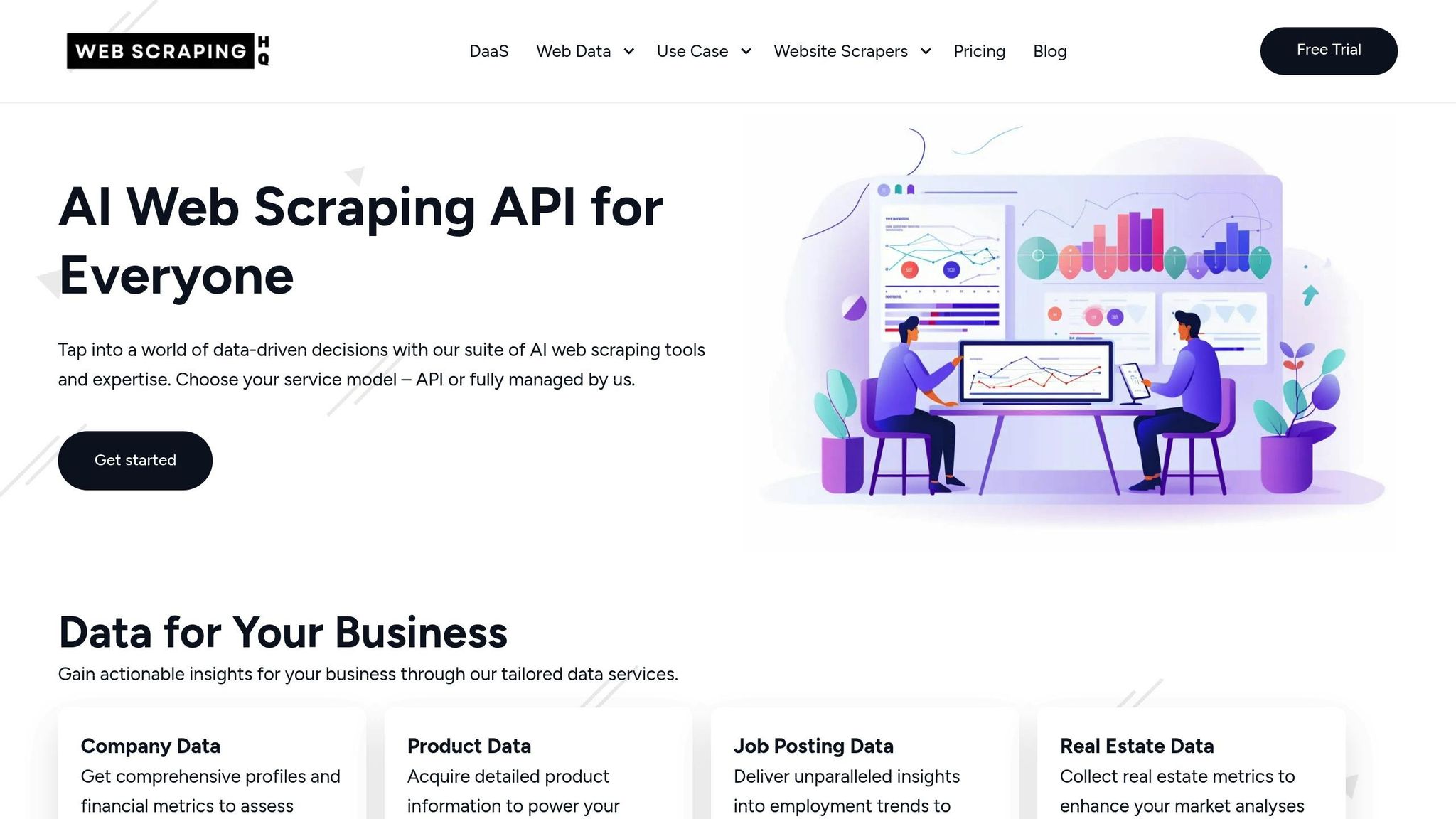
- Harsh Maur
- March 28, 2025
- 8 Mins read
- WebScraping
How Real Estate Scraping Helps Investors Identify Profitable Properties
Real estate scraping is an automated way to gather property data from websites, helping investors make smarter decisions. With 97% of homebuyers starting online, having accurate data is crucial. Here's how it helps:
- Find undervalued properties by analyzing listings and price history.
- Track market trends to time purchases better.
- Understand neighborhoods with demographics, growth, and infrastructure data.
- Estimate returns using metrics like ROI, cap rate, and rental yields.
Key Benefits:
- Faster decisions: Automate data collection from sources like Zillow, Realtor.com, and public records.
- Smarter choices: Use metrics like price per square foot, rent multipliers, and appreciation rates.
- Risk reduction: Analyze sales history and market conditions to avoid bad investments.
Tools you'll need: Web scraping software, proxy networks, and data processing tools for clean, actionable insights. Always follow legal guidelines like GDPR and site-specific rules.
Real estate scraping saves time, reduces risks, and gives investors a competitive edge by turning data into actionable insights.
Must-Have Property Data Points
Basic Property Details
Here are some key property details to consider:
| Property Detail | Why It Matters | Data Sources |
|---|---|---|
| List Price | Sets the baseline for your investment budget | Zillow, Realtor.com |
| Square Footage | Helps calculate price per square foot | MLS, PropertyShark |
| Bedrooms/Bathrooms | Impacts rental appeal and target market | Trulia, Apartments.com |
| Year Built | Indicates potential maintenance needs | County Records |
| Lot Size | Evaluates the potential for development or expansion | Property Tax Records |
Additional features like HVAC systems, parking availability, and recent renovations can help refine estimates for repair costs and potential returns. To further enhance your analysis, consider historical sales trends, which provide valuable insights into market performance over time.
Past Sales Records
Historical sales data can offer a clearer picture of potential appreciation and help cut investment risks by up to 25%[1]. Focus on these metrics:
- Sale prices, dates, and appreciation rates
- Average days properties stay on the market
- Trends in price reductions
- Foreclosure history
By analyzing these figures, investors can adjust their strategies to align with market trends. Pair this information with local neighborhood data for a more precise assessment of a property's long-term value.
Area Statistics
Neighborhood data is just as important as property-specific details. Here are some crucial metrics:
| Metric Category | Key Indicators | Why It Matters |
|---|---|---|
| Demographics | Population growth, income levels | Helps predict rental demand |
| Education | School ratings, proximity to schools | Supports stable property values |
| Economic | Employment rates, new business permits | Signals potential for appreciation |
| Infrastructure | Public transit, planned developments | Indicates future value growth |
Resources like the U.S. Census Bureau and local government databases are great for demographic insights. Tools like the Walk Score API can provide detailed information on neighborhood amenities. When combined with broader economic data, such as employment trends, new development projects, and infrastructure updates, these insights paint a fuller picture of a property's investment potential.
Building Your Data Collection System
Choosing Data Tools
To collect real estate data efficiently, it's crucial to pick the right tools. Web Scraping HQ's managed services are designed specifically for real estate investors, offering automated data extraction that processes thousands of property listings daily while ensuring data quality and compliance with legal standards.
Here’s a breakdown of the key tools you’ll need:
| Component | Purpose | Key Advantages |
|---|---|---|
| Web Scraping Solution | Automates data collection | Outputs structured JSON/CSV, regular updates |
| Proxy Network | Access restricted data | Provides location-specific property insights |
| Data Storage System | Organizes collected data | Enables historical trend analysis and quick retrieval |
| Data Processing Tools | Cleans and standardizes data | Ensures accurate analysis and reliable insights |
Once your tools are in place, the next step is identifying trustworthy data sources.
Finding Data Sources
To build a robust system, focus on these essential data sources:
| Data Type | Key Sources | Information Provided |
|---|---|---|
| Property Listings | Zillow, Realtor.com, Trulia | Current prices, property details |
| Transaction History | County Records, RealtyTrac | Past sales, foreclosure data |
| Market Analytics | Zillow Research, CoreLogic | Price trends, market indicators |
| Neighborhood Data | Walk Score API, PolicyMap | Area statistics, demographics |
Processing Raw Data
After gathering your data, refine it to make it actionable. Here’s how:
1. Data Cleaning
- Remove duplicate entries
- Standardize units (e.g., square feet for area, USD for prices)
- Normalize addresses for consistency
2. Data Enrichment
- Add extra details like school ratings, crime stats, local economic indicators, and transportation scores
- Compare prices with recent sales data
- Double-check property details with county records
- Identify and investigate any outliers in square footage or price per square foot
- Ensure location coordinates align with street addresses
"Web scraping in real estate is the automated extraction of data from property websites, making it easy to access listings, prices, and market insights in bulk." - HasData
Finding Good Investment Properties
Investment Calculations
Scraped data makes it possible to calculate key metrics that investors rely on, such as ROI, which often falls between 8% and 12%. Here are some important calculations to know:
| Metric | Formula | Typical Range |
|---|---|---|
| Cash-on-Cash Return | (Annual Cash Flow / Total Cash Invested) × 100 | 8–12% |
| Cap Rate | (Net Operating Income / Property Value) × 100 | 4–10% |
| Price per Square Foot | Total Price / Square Footage | Market dependent |
| Gross Rent Multiplier | Property Price / Annual Gross Rent | 4–7 |
These metrics allow investors to compare potential returns and make informed decisions based on data. They also help pinpoint undervalued opportunities.
Finding Below-Market Properties
Spotting below-market properties requires analyzing multiple data points at once. The two main strategies include:
- Price History Analysis
Compare current prices with historical sales and market averages. Properties priced at least 10% below similar homes - especially those with recent price reductions, long market times, or signs of distress - can provide better returns.
- Property Condition Assessment
Review listings and photos to find properties needing minor repairs that could increase their value. Key resources to cross-check include:
- Building permit records
- Tax assessments
- Past renovation details
After identifying undervalued properties, consider broader market trends to confirm their long-term potential.
Market Growth Indicators
Beyond individual property metrics, understanding market trends is essential for identifying areas with sustainable growth. Look for these key indicators:
| Indicator | Data Source | Growth Signal |
|---|---|---|
| Population Growth | Census Data | Over 2% annual increase |
| Employment Rate | Bureau of Labor Statistics | Increasing job numbers |
| New Business Permits | Local Government Records | More than 5% yearly growth |
| Infrastructure Projects | City Planning Records | Upcoming developments |
Track yearly changes in factors like market days, rental rates, price per square foot, and new permits. Areas showing multiple positive trends often signal strong growth potential. Additionally, keeping properties well-maintained, ensuring high occupancy rates, and collecting rent on time can further improve ROI and overall performance.
sbb-itb-65bdb53
Rules and Guidelines
Website Rules
To follow a website's terms, check its robots.txt file by adding "/robots.txt" to the domain URL. This file outlines areas that are off-limits for scraping.
Many real estate websites have measures in place to limit excessive scraping. Here's a quick overview:
| Protection Type | Impact | Solution |
|---|---|---|
| Rate Limiting | Blocks excessive requests | Space out requests appropriately |
| CAPTCHA Systems | Blocks automated access | Use advanced handling techniques |
| IP Blocking | Restricts access from certain IPs | Use rotating IP addresses |
| JavaScript Challenges | Requires browser-like behavior | Use sophisticated scraping tools |
In addition to these technical barriers, always ensure compliance with privacy regulations when collecting data.
Data Protection Laws
The General Data Protection Regulation (GDPR) plays a major role in how property data is collected and used, especially for properties or owners based in the EU.
Key compliance points include:
- Personal Data Handling: Only collect necessary personal data, and ensure explicit consent is obtained. Securely store data while documenting its purpose, retention period, access controls, and deletion process.
-
Data Storage Requirements: Maintain detailed records of:
- Why was the data collected
- How long will it be stored
- Who can access it
- Procedures for deleting it
Following these legal guidelines is just as important as using the right data tools.
Best Practices
Once you've addressed website restrictions and legal compliance, it's important to adopt ethical scraping practices. For example, a notable case where eBay successfully fought against excessive scraping highlights the risks of unethical methods.
| Best Practice | Implementation | Benefit |
|---|---|---|
| Request Spacing | Send requests 1–2 seconds apart | Prevents server overload |
| Data Minimization | Collect only the necessary fields | Reduces legal risks |
| Source Attribution | Keep track of where the data comes from | Ensures traceability |
| Regular Updates | Refresh data periodically | Maintains accuracy |
"Checking whether a website allows scraping is an ethical responsibility and a critical step before starting any data extraction project." - Data Journal
Main Points Review
Real estate scraping is a game-changer for investors looking to identify profitable properties. With 97% of homebuyers starting their search online, having access to detailed property data is crucial for making smart investment decisions.
| Benefit | Impact |
|---|---|
| Market Insights | Use real-time pricing trends to time deals |
| Spotting Opportunities | Find undervalued properties in growth areas |
| Managing Risks | Make informed choices to reduce exposure |
| Staying Competitive | Act quickly on prime listings |
Automating this process allows investors to analyze thousands of listings daily - something that would be nearly impossible manually. This efficient method combines advanced data collection with actionable insights, giving investors a strong edge.
Web Scraping HQ Services

Our real estate scraping services are designed to help you make the most of these benefits. Starting at $449 per month, we offer structured data delivered in JSON or CSV formats, along with automated quality checks.
- Standard Plan: Includes expert consultation and compliance monitoring.
- Custom Plan: Tailored enterprise solutions with custom data structures and rapid support.
With these services, you can:
- Build detailed property databases
- Track changing market conditions
- Create reports that drive smarter investments